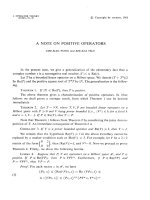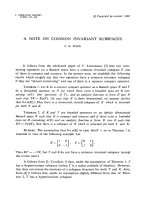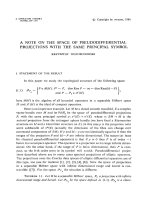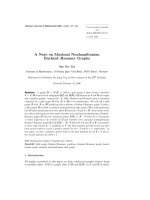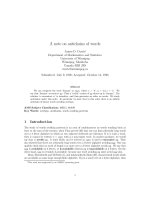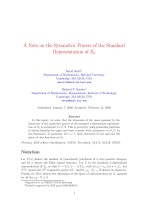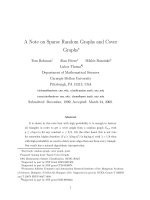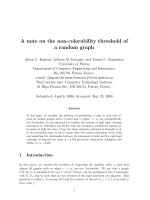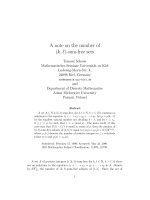Báo cáo toán học: "A note on antichains of words" potx
Bạn đang xem bản rút gọn của tài liệu. Xem và tải ngay bản đầy đủ của tài liệu tại đây (132.85 KB, 7 trang )
A note on antichains of words
James D. Currie
∗
Department of Mathematics and Statistics
University of Winnipeg
Winnipeg, Manitoba
Canada R3B 2E9
Submitted: July 9, 1995; Accepted: October 14, 1995
Abstract
We can compress the word ‘banana’ as xyyz,wherex =‘b’,y =‘an’,z =‘a’. We
say that ‘banana’ encounters yy. Thus a ‘coded’ version of yy showsupin‘banana’. The
relation ‘u encounters w’ is transitive, and thus generates an order on words. We study
antichains under this order. In particular we show that in this order there is an infinite
antichain of binary words avoiding overlaps.
AMS Subject Classification: 68R15, 06A99
Key Words: overlaps. antichains, words avoiding patterns
1 Introduction
The study of words avoiding patterns is an area of combinatorics on words reaching back at
least to the turn of the century, when Thue proved [29] that one can find arbitrarily long words
over a 3 letter alphabet in which no two adjacent subwords are identical. If w is such a word,
then w cannot be written w = xyyz with y a non-empty word. In modern parlance, we would
say that w avoids yy. A word which can be written as xyyz is said to encounter yy.Thue
also showed that there are arbitrarily long words over a 2 letter alphabet avoiding yyy.Onecan
quickly check that no word of length 4 or more over a 2 letter alphabet avoids yy. We say that
yyy is avoidable on 2 letters, or 2-avoidable whereas yy is unavoidable on 2 letters. On the
other hand, yyy is certainly 3-avoidable, because any word avoiding yy must avoid yyy also.
Bean, Ehrenfeucht and McNulty [4], and independently Zimin [30], characterized words which
are avoidable on some large enough finite alphabet. If p is a word over an n letter alphabet, then
∗
This work was supported by an NSERC operating grant.
1
the electronic journal of combinatorics 2 (1995), #R21 2
p is avoidable on some finite alphabet if Z
n
avoids p, where words Z
n
are defined recursively by
Z
1
=1
Z
n+1
= Z
n
(n +1)Z
n
,n ∈ IN .
Thus the pattern abcacb is a pattern over a 3 letter alphabet, and is avoided by Z
3
= 1213121.
It follows that abcacb is avoidable on some large enough finite alphabet. The size of the smallest
alphabet on which abcacb is avoidable isn’t known. No avoidable pattern is known which is not
4-avoidable. The following conjecture is given by Baker [2]:
Conjecture 1.1 Every avoidable pattern is 4-avoidable.
The following problem has been open since 1979 [4]:
Problem 1.2 Find an algorithm which given a word p determines the smallest k such that p
is k-avoidable.
Cassaigne and Roth [8, 27] studied avoidable binary and ternary patterns p, giving when
possible the smallest k for which p is k-avoidable. In such work, the most important patterns
are the minimal ones; as discussed above, yyy is 3-avoidable because it contains yy. Similarly,
if w is 3-avoidable, then so is w
R
, the reverse of w. It follows from the work of Cassaigne and
Roth that a binary pattern is 2-avoidable exactly when it encounters one of xxx, xyxyx, xyxxy,
xxyxyy, xyxyyx and xxyyx. Consideration of minimal k-avoidable patterns leads to problems
such as the following, posed in [3]:
Problem 1.3 Write u ≥ w if u encounters w or the reversal of w. This relation is a quasi-order,
and factoring out the resulting equivalence relation gives a partial order. Let µ(w) be the size
of the smallest alphabet on which w is avoidable. For avoidable w, is there an infinite antichain
on µ(w) letters such that each member of the antichain avoids w?
Perhaps the posing of this problem is too ambitious. An affirmative solution would imply
that for any avoidable word w, it takes no more letters to avoid w and w
R
simultaneously than it
does to avoid w alone. Strong evidence to the contrary is provided by the example w = abcacb.
It seems likely that abcacb is 2-avoidable; there are words of length 1000 over {0, 1} avoiding
abcacb.However,abcacb and bcacba are not simultaneously 2-avoidable.
1
For this reason, it seems that a better question to ask is the following:
Problem 1.4 Write u ≥ w if u encounters w. For avoidable w, is there an infinite antichain on
µ(w) letters such that each member of the antichain avoids w?
This question was answered in the affirmative in the case where w is 2-avoidable in [18] Note
that for the sake of studying antichains it is unnecessary to move from the quasi-order to a
partial order.
In a related paper [9] it was shown that for any >0 there is an infinite antichain of such
ternary words avoiding x
k
for 7/4 <k<7/4+. Note that 7/4isthethreshold of repetition
1
Thanks to Kirby Baker for the use of his software which allowed the author to make these discoveries
concerning abcacb.
the electronic journal of combinatorics 2 (1995), #R21 3
for words over a 3 letter alphabet; if r<7/4, we can find at most finitely many words over a 3
letter alphabet avoiding x
r
.
The threshold of repetition for a 2 letter alphabet is 2. A word containing no subwords of
the form x
k
for k>2 is called overlap-free. A word is overlap-free exactly when it avoids both
the patterns xxx and xyxyx.
In this note we prove that any binary word which avoids overlaps is an element of an infinite
antichain of binary words avoiding overlaps.
2 Preliminaries
An alphabet Σ is a set whose elements are called letters.Aword w over Σ is a finite string
of letters from Σ. The length of word w is the number of letters in w, denoted by |w|. Thus
|banana| = 6, for example. The language consisting of all words over Σ is denoted by Σ
∗
.
If x, y ∈ Σ
∗
, the concatenation of x and y, written xy, is simply the string consisting of x
followed by y. The word with no letters is called the empty word and is denoted by . Suppose
w ∈ Σ
∗
. We call word x a prefix of w if w = xy, some y ∈ Σ
∗
. Similarly word y is a suffix of w
if we can write w = xy, some x ∈ Σ
∗
. We call y a subword of w if we can write w = xyz, some
x, z ∈ Σ
∗
. In the case that x and z are non-empty, y is an internal subword of w.
Let Σ, T be alphabets. A substitution h :Σ
∗
→ T
∗
is a function generated by its
values on Σ. That is, suppose w ∈ Σ
∗
,w = a
1
a
2
a
m
; a
i
∈ Σfori =1tom. Then
h(w)=h(a
1
)h(a
2
) h(a
m
). A substitution is non-erasing if for every a ∈ Σ, |h(a)|= .
Let w,v be finite words over some alphabet Σ. We say that w encounters v if w = xh(v)y
for some non-erasing substitution h :Σ
∗
→ Σ
∗
. Otherwise we say that w avoids v. If x is a word
we denote by x
n
the word consisting of x repeated n times in a row. Thus x
2
= xx, x
3
= xxx
and so on. We call a word w a k-power if w = x
k
, some x = . A 2-power is also called a
square.Anoverlap is a word of form xxx or xyxyx for some words x and y.Awordw is
k-power free if we cannot write w = xyz, where y is a k-power. Thus w is k-power free if w
avoids x
k
. Similarly one speaks of square-free or overlap-free words.
An ω-word over alphabet Σ is an infinite sequence of letters of Σ. If w = {w
i
}
i∈IN
is an
ω-word over Σ, then each finite initial segment w
1
,w
2
, ,w
n
of w will correspond to some word
w
1
w
2
w
n
of Σ
∗
. In this case we say that w
1
w
2
w
n
is a prefix of ω-word w. If u is an
ω-word over Σ we say that u encounters w if some finite prefix of u encounters w. Otherwise,
we say that u avoids w.
We say that w is k-avoidable if the set of words over Σ avoiding w is infinite, for some,
hence for any, alphabet Σ of size k. Equivalently, w is k-avoidable if there is an ω-word over
an alphabet of size k which avoids w.Ifw is k-avoidable for some k ∈ IN w e s a y t h a t w is
avoidable. Otherwise, w is unavoidable.LetS be a set of words. We say that v avoids S if
v avoids each w ∈ S.
Fix an alphabet Σ. The relation ‘w encounters v’ is a quasi-order on Σ
∗
which we will
abbreviate by w ≥ v. We will be interested in the quasi-ordered set Σ
∗
, ≥.
Lemma 2.1 Suppose that A⊆Σ
∗
is an infinite antichain. Then there is an ω-word over Σ
avoiding A.
Proof: Let A = {w
i
}
∞
i=1
. If w is a non-empty word, denote by w
the word obtained from w by
deleting the last letter.
the electronic journal of combinatorics 2 (1995), #R21 4
We claim that for each i ∈ IN ,w
i
avoids A :Ifv ≤ w
i
then v ≤ w
i
by transitivity. Thus if
j = i, then w
i
avoids w
j
, because w
j
and w
i
are incomparable. On the other hand, since w
i
is
shorter than w
i
, certainly w
i
avoids w
i
.
Since A is an infinite set of words over a finite alphabet, A contains arbitrarily long words.
Thus the set A
= {w
i
}
∞
i=1
contains arbitrarily long words of Σ
∗
avoiding A. It follows by K¨onig’s
Infinity Lemma that there is an ω-word over Σ avoiding A.✷
Lemma 2.2 Let S be a finite set of avoidable words. Then there is an ω-word over a finite
alphabet avoiding S.
Proof: This is proved in [4, 30]. Let S = {s
i
:1≤ i ≤ m}. Fo r each i pick n
i
∈ IN
and an ω-word w
i
= {w
ij
}
∞
j=1
over an alphabet Σ
i
of size n
i
avoiding s
i
. Then the word
w = {(w
1j
,w
2j
, ,w
mj
)}
∞
j=1
over the alphabet
m
i=1
Σ
i
avoids s.✷
To avoid S it suffices to avoid a maximal antichain of minimal elements of S. Thus we could
get by with a version of this lemma in which S was restricted to be an antichain.
Corollary 2.3 Suppose that A⊆Σ
∗
is a finite antichain. Then there is an ω-word over some
finite alphabet avoiding A.
Remark 2.4 It is striking that infinite antichains over finite sets are easier to avoid than finite
antichains! That is, to avoid a finite antichain over S it may be necessary to move to a larger
alphabet, whereas this is not the case with infinite antichains. To give a concrete example, let
S bethesetofallwordsoflength7overΣ={a, b}. Each word of S is 2-avoidable, but any
binary word of length 7 or more encounters an element of S.
An image of xxx or xyxyx under a non-erasing substitution is called an overlap. Note that a
prefix of an overlap will be a square.
Theorem 2.5 There is an infinite antichain of binary words avoiding overlaps.
Proof: Following Thue [29], Define the map h : {a, b}
∗
→{a, b}
∗
by h(a)=ab, h(b)=ba. Let l
= aabaab. Thus l
R
= baabaa. We see that the prefixes of l which are suffixes of l
R
are exactly
a, aa, aabaa.
Lemma 2.6 Word l is avoided by h
ω
(a).
Proof: This was proved by Cassaigne [8, Section 2.6, Th´eor`eme 2.2]. ✷
Corollary 2.7 The word l
R
, the reverse of l,isavoidedbyh
ω
(a).
Let n ∈ IN. Then we can write h
2n+2
(a)=abbabaabu
n
baababba for some word u
n
. Let
m
n
= aabaabu
n
baabaa.
Remark 2.8 Word l is a prefix and suffix of each m
n
, but every internal subword of m
n
is a
subword of h
ω
(a). It follows that l doesn’t appear in m
n
internally. We note that for each n,
m
n
is a palindrome.
Lemma 2.9 Let n ∈ IN .Thenthewordm
n
is overlap-free.
the electronic journal of combinatorics 2 (1995), #R21 5
Proof: Every internal subword of m
n
is a subword of h
ω
(a), and is overlap-free. It remains to
show that no prefix or suffix of m
n
is an overlap. As m
n
is a palindrome, we need only show
that no prefix of m
n
is an overlap.
First note that no prefix of m
n
is a square of length 12 or greater; otherwise the prefix of m
n
of length 6 reappears internally, i.e. m
n
contains an l internally, which is impossible. It follows
that the shortest overlap which is a prefix of m
n
has length at most 11, and is a prefix of m
1
.
Inspection shows that no prefix of m
1
of length 11 or less is an overlap.✷
Theorem 2.10 The set {m
n
}
n∈IN
is an antichain.
Proof: Let i, j ∈ IN ,i<j.Clearly m
i
doesn’t encounter m
j
since m
j
is longer than m
i
. Suppose,
for the sake of a contradiction, that m
j
encounters m
i
. Say that m
j
= αf(m
i
)β where f is a
non-erasing substitution.
If α = then an internal subword of m
j
encounters the prefix l of m
i
. Thus a subword of
h
ω
(a) encounters l. This is impossible by Lemma 2.6. Thus α = . Symmetrically, β = .
Since a is a prefix of m
i
, f(a)isaprefixofm
j
. Thus l and f(a) are both prefixes of m
j
,
and one must be a prefix of the other. Since a is an internal subword of m
i
, f(a)isaninternal
subword of m
j
. Thus l is not a prefix of f(a). We conclude that f(a) is a proper prefix of l.
Symmetrically, f(a)mustbeapropersuffixofl
R
, the reverse of l. Thus f(a)=a, aa or aabaa.
However, aa is a subword of m
i
, so that f(aa) is a subword of the overlap-free word m
j
. We
conclude that f(a)=a.
We have so far determined f(a). Now consider f(b). Since f(m
i
)=m
j
is longer than m
i
,
the length of f(b) is greater than 1. Since aab and baa are subwords of m
i
, both aaf (b)and
f(b)aa are subwords of m
j
. It follows that f(b)hasb as a prefix and a suffix, since otherwise
aaa appears in m
j
, a contradiction since m
j
is overlap-free.
Since aab is a prefix of m
i
,f(aab)=aaf(b)isaprefixofm
j
. However, another prefix of
m
j
is aabaab. Thus one of f (b)andbaab is a prefix of the other. Since f(b) begins and ends
with a b, we conclude that baab is a prefix of f(b). As aab appears internally in m
i
, we conclude
that f(aab) occurs internally in m
j
. Aprefixoff(aab)isaabaab = l. It follows that l appears
internally in m
j
, and hence that l is a subword of h
ω
(a). This contradicts Lemma 2.6.
The supposition that m
j
encounters m
i
leads to a contradiction. We conclude that m
i
and
m
j
are incomparable, and that in fact {m
n
}
n∈IN
is an antichain. ✷.
References
[1] S. Arˇson, D´emonstration de l’existence des suites asym´etriques infinies, Mat. Sb., (N.S.) 2,
769–779; Zbl. 18,115.
[2] Kirby A. Baker, Some problems on avoidability. Expos´e au LITP, 1992.
[3] Kirby A. Baker, George. F. McNulty & Walter Taylor, Growth problems for avoidable
words, Theoret. Comput. Sci. 69 (1989), no. 3, 319–345; MR 91f:68109.
[4] Dwight R. Bean, Andrzej Ehrenfeucht & George McNulty, Avoidable Patterns in Strings
of Symbols, Pacific J. Math. 85 (1979), 261–294; MR 81i:20075.
the electronic journal of combinatorics 2 (1995), #R21 6
[5] J. Brinkhuis, Non-repetitive sequences on three symbols, Quart. J. Math. Oxford Ser.(2)
34 (1983), 145–149; MR 84e:05008.
[6] T. C. Brown, Is there a sequence on four symbols in which no two adjacent segments are
permutations of each other?, Amer. Math. Monthly 78 (1971), 886–888.
[7] Stanley Burris & Evelyn Nelson, Embedding the dual of in the lattice of equational classes
of semigroups, Algebra Universalis, 1 (1971/72), 248–253; MR 45 #5257.
[8] Julien Cassaigne, Motifs ´evitables et r´egularit´e dans les mots, Th`ese de Doctorat, Universit´e
Paris VI, Juillet 1994.
[9] Max Crochemore & Pavel Goralcik, Mutually avoiding ternary words of small exponent,
Internat. J. Algebra Comput. 1 (1991) 407–410.
[10] James D. Currie, Non-repetitive walks in graphs and digraphs, PhD thesis, University of
Calgary (1987).
[11] James D. Currie, Which graphs allow infinite non-repetitive walks? Discrete Math. 87
(1991), 249–260; MR 92a:05124.
[12] James. D. Currie, Open problems in pattern avoidance, Amer. Math. Monthly 100 (1993),
790–793.
[13] James. D. Currie, Non-repetitive words: ages and essences, Combinatorica, to appear.
[14] F.M.Dekking,Strongly non-repetitive sequences and progression-free sets, J. Combin Theory
Ser. A, 27 (1979), 181–185; MR 81b:05027.
[15] Fran¸coise Dejean, Sur un th´eor`eme de Thue, J. Combin. Theory Ser. A 13 (1972), 90–99.
[16] Roger C. Entringer, Douglas E. Jackson & J.A. Schatz, On non-repetitive sequences, J.
Combin. Theory Ser. A 16 (1974), 159–164; MR 48 #10860.
[17] Earl D. Fife, Binary sequences which contain no BBb, Trans. Amer. Math. Soc. 261 (1980),
115–136; MR 82a:05034
[18] Pavel Goralcik & Tomas Vanicek, Binary Patterns in Binary Words, Internat. J. Algebra
Comput. 1 (1991) 387–391.
[19] Andres. del Junco, A transformation with simple spectrum which is not rank one, Canad.
J. Math. 29 (1977), 655–663; MR 57 #6367.
[20] Jacques Justin, Characterization of the repetitive commutative semigroups, J. Algebra 21
(1972), 87–90; MR 46#277.
[21] Juhani Karhum¨aki, On cube-free ω-words generated by binary morphisms, Discrete Appl.
Math. 5 (1983), 279–297; MR 84j:03081.
[22] Veikko Ker¨anen, Abelian squares are avoidable on 4 letters, Automata, Languages and
Programming: Lecture notes in Computer Sciences 623 (1992) Springer-Verlag 4152.
the electronic journal of combinatorics 2 (1995), #R21 7
[23] Filippo Mignosi, Infinite words with linear subword complexity, Theoret. Comput. Sci. 65
(1989), 221–242; MR 91b:68093.
[24] Marston Morse & Gustav A. Hedlund, Symbolic dynamics I, II, Amer. J. Math. 60 (1938),
815–866; 62 (1940) 142; MR 1, 123d.
[25] P. S. Novikov & S. I. Adjan, Infinite periodic groups I, II, III, Izv. Akad. Nauk. SSSR Ser.
Mat. 32 (1968), 212–244;251–524;709–731;MR 39 #1532a–c.
[26] P. A. B. Pleasants, Non-repetitive sequences, Proc. Cambridge Philos. Soc. 68 (1970),
267–274; MR 42 #85.
[27] Peter Roth, Every binary pattern of length six is avoidable on the two-letter alphabet,
Interner Bericht 6/89, Fachbereich Informatik, Universit¨at Frankfurt.
[28] Robert. O. Shelton & Raj P. Soni, Aperiodic words on three symbols I, II, III, J. reine
agnew. Math. 321;327;330 (1981), 195–209;1–11;44–52; MR 82m:05004a–c.
[29] Axel Thue,
¨
UberunendlicheZeichenreihen,NorskeVid.Selsk.Skr.I.Mat.Nat.Kl.Chris-
tiana (1912), 1–67.
[30] A. Zimin, Blocking sets of terms, Mat. Sb. (N.S.) 119 (161) (1982); Math. USSR Sbornik
47 (1984), 353–364.
